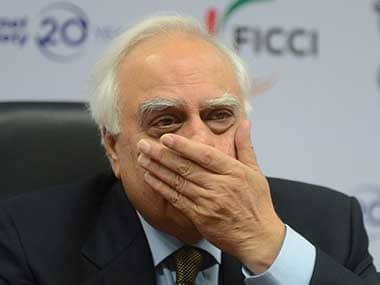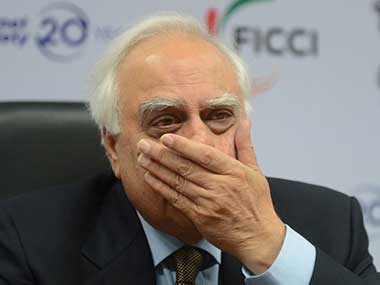New Delhi: Spectrum pricing is once again making various arms of the government run around in circles.
Are these smoke signals before the price of 900 mhz and 1800 mhz spectrum bands is reduced once again to pander to demands of the powerful telecom operators’ lobby?
Not only has Telecom Minister Kapil Sibal shown no urgency in determining the price of spectrum for the next round of auctions, his ministry and even the sector regulator are obviously reluctant to address this vital parameter without which auctions cannot be called.
[caption id=“attachment_844261” align=“alignright” width=“380”]  Telecom Minister Kapil Sibal shown no urgency in determining the price of spectrum for the next round of auctions. AFP[/caption]
The Department of Telecom has indicated that it wants price to be reduced but does not want to be seen doing so itself. So it has asked sector regulator TRAI for an analysis. But TRAI is also becoming image conscious under chairman Rahul Khullar and does not want to bell the spectrum cat.
The Department of Telecom (DoT) has already said reduction in price of 2G spectrum that will now be put up for auction is one option before the EGoM has approached TRAI. Khullar, however, he said in an interview to the Hindu Business Line yesterday that “the main issue is about pricing of spectrum of 900 mhz and 1800 mhz. That is up to the government to take a decision.”
So TRAI is washing its hands off the pricing issue and now, the empowered group of ministers chaired by the Finance Minister will take a final call. But when?
Impact Shorts
More ShortsThe situation becomes even more ludicrous if what the Economic Times says this morning is correct. Quoting from the reply DoT has sent to the Comptroller & Auditor General (CAG), the story speaks of DoT’s silence on CAG’s allegation that telcos could present previous failed auctions as a case for reduction in reserve price of spectrum.
“The DoT remained silent on the issue,” the story said.
This, when the DoT has loudly contested the CAG allegation that it allowed telcos to form a cartel in the two previous auctions in November 2012 and March 2013 where telcos’ participation was a reduced to a joke.
DoT’s silence could well mean acquiescence with telcos who have made a case for lower prices by pointing out their stretched balance sheets and the urgent need for more spectrum in many circles to improve quality of mobile services.
The CAG has already sought an explanation from DoT on two charges:
Telcos formed a cartel to make the two auctions a failure so that they derive the muscle to get spectrum base price reduced. It has also alleged that the DoT priced the 2G spectrum for these two auctions at a very high price which led to auctions failing.
Inadequate spectrum with telcos and excessive subscriber numbers with respect to quantity of spectrum held by them has led to a decline in service standards across telecom circles.
The ET story also makes another startling point: the DoT has written in its reply to CAG that auctions in the last two rounds failed since telcos perhaps did not need more spectrum as minutes spoken over a mobile phone company’s network, improved technology that enables more efficient use of spectrum and operators using 3G spectrum to provide 2G services.
The DoT may be partly right but its response is largely akin to pulling wool over the CAG’s eyes. In its observations, the CAG had given numerous instances when telcos made multiple requests for additional spectrum in the last decade and notched up a quantum jump in subscriber numbers despite not getting more spectrum in this time period.
These very same telcos did not need more spectrum when auctions were held? Very hard to believe that DoT is right in its reading of the situation.
Some instances of CAG observing otherwise:
- Bharti Airtel made as many as 68 applications for additional spectrum for 21 service areas (excluding Delhi) between 2008-2011 but still made only a token participation in November auctions where it bought just 1.25 mhz for Assam service area. It made requests for additional spectrum at least 11 times during 2008-2011 for Delhi circle citing urgent requirements but did not bid for Delhi service area either in November or in March auctions.
Vodafone Essar sought additional spectrum in Delhi circle through 15 applications since 2003 but none was allotted to it. The company chose not to participate in auctions for Delhi in November and in March.
By 2013, Idea Cellular was providing cellular services to 28.86 lakh subscribers with 4.4 mhz spectrum in Mumbai service area which is more than five times the subscriber base criteria set by DoT. Idea has been repeatedly requesting for additional spectrum since February 2009 when its subscriber base was hardly 6 lakh but did not participate in the auction for Mumbai in recent auctions. Idea did not even obtain 3G spectrum for Mumbai in 2010 auctions. Idea made repeated requests for additional spectrum since 2006, the last request was made on February 28, 2011. But no participation in either auction thereafter.
Reliance Communications is catering to 40.96 lakh GSM subscribers in Delhi by December 2012 with 4.4 mhz spectrum, which is more than eight times the subscriber criteria of 5 lakh. It did not participate in the November auctions for Delhi; in other 12 service areas also it continues to provide service to subscribers many times more than what is prescribed by DoT.
- Tata Tele has also been repeatedly requesting DoT for more spectrum but did not participate in either auction.
So Mr Sibal, there are a lot of questions around auctions - failed previous auctions, apparent cartelisation by telcos, failure by them to adhere to quality of service norms and now the biggest question of all is over pricing of spectrum. We need some answers, and fast.


)

)
)
)
)
)
)
)
)



